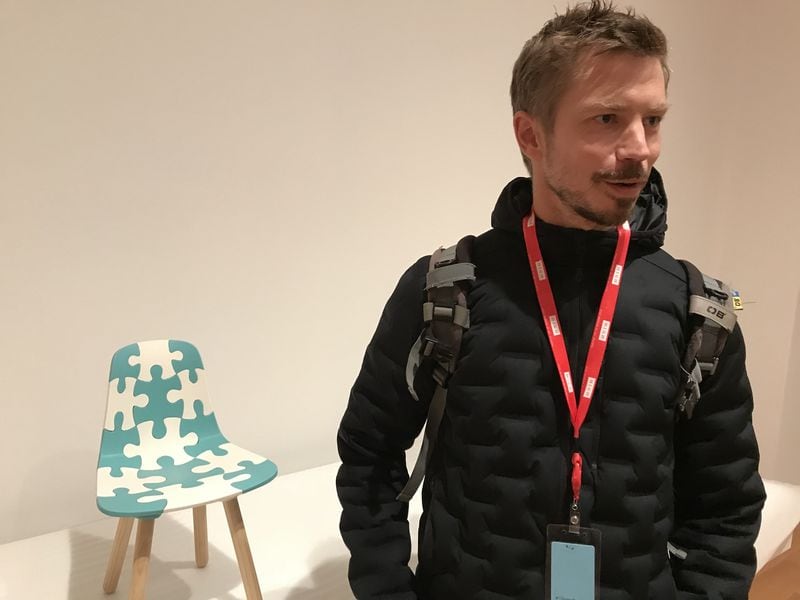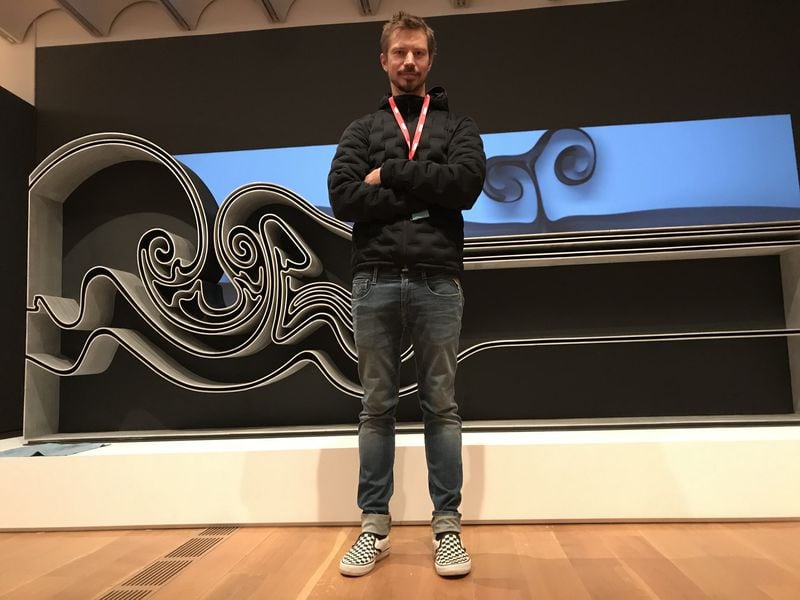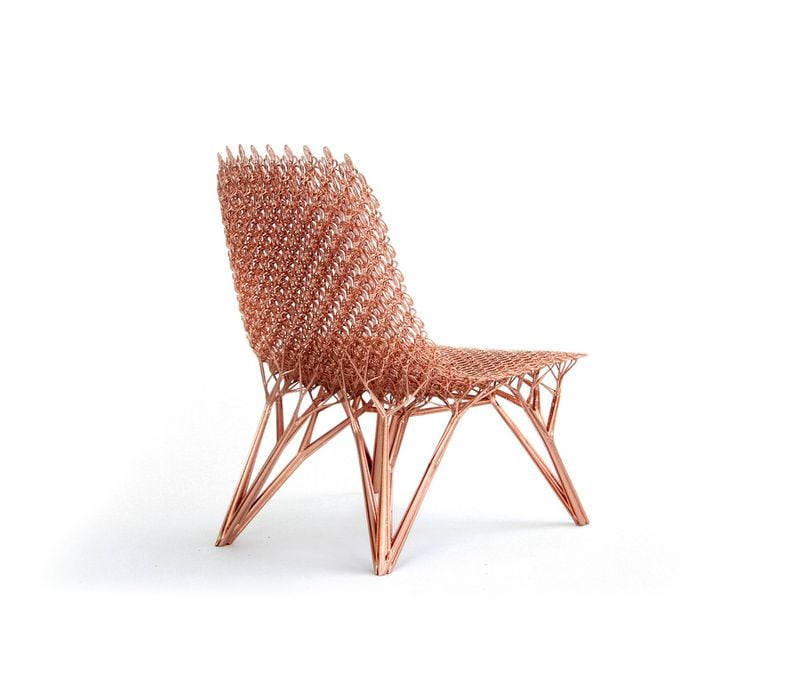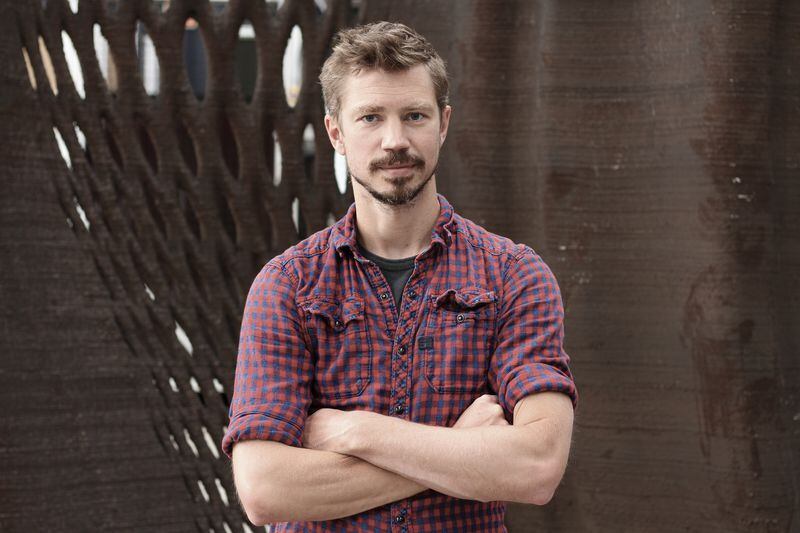Joris Laarman is at the edge of the edge.
He uses robots and computer programs and artificial intelligence to build bridges and radiators and bioluminescent desk lamps. And it all scares him.
"It's exciting and terrifying," he said, trekking around the High Museum of Art in checkered sneakers and skinny jeans. "It's like a train racing into the future at top speed. Where is it going?"
Wherever it’s going, Laarman, 38, is probably already there.
On a recent afternoon, he entered an exhibit of his work at the High, "Joris Laarman Lab: Design in the Digital Age," and headed for a display of a lamp he calls Half Life. It uses genetically modified hamster cells, crossed with firefly DNA, and glows without benefit of electricity. One simply must feed it regularly.
Playing on another wall in the exhibit hall was a video of an automotive designer who developed an algorithm to strip unnecessary weight from an engine block. Laarman borrowed that mathematical tool and unleashed it on some of his furniture designs.
A video shows how one of his chairs shrinks into form by steady erasure. (As Michelangelo might say, the program carves away everything that doesn't look like a chair.) "It's not just to make it more smart and efficient, but to make it beautiful," said Laarman.
The High has the largest public collection of work by this Dutch designer outside of the Netherlands. Wandering through the High and looking at the exhibit (organized by the Groninger Museum in the Netherlands), Laarman has the fresh, surprised look of a teenager who has discovered that he has superpowers.
“I’m the first generation to grow up with computers. I still remember how we used to look for things before there was Google, what life was like before we were constantly online,” he said. “Without the internet, I would never have done all these things. It’s like magic. It’s like Harry Potter in Hogwarts.”
There is a playful delight in these creations, evidence that Laarman enjoys harnessing these powers simply because he can. But there is a more serious intent as well.
Furniture design used to involve shipping a plan to China, where items would be constructed and then shipped back again, he said.
Instead of all that wasted fuel moving products around, the 3-D printer offers a way to have a design constructed close to home. “If you know how robots work, and how software works, you can make a design, put it on the internet, send it to the other side of the world, and you don’t have to ship materials back and forth,” he said. “It makes the creatives more powerful, and they should be. Creatives ought to be in charge.”
Laarman’s biomorphic designs appear to draw inspiration from living things. A climbing wall looks like a trailing vine. A radiator resembles a dense hedge.
But for some of these creations, the relationship goes deeper than surface resemblance. His bone furniture applies the algorithm that controls the growth of avian bones, balancing lightness and strength. These designs actually come from the mathematics that make living things look the way they do.
As he explores this computer-generated future, Laarman doesn’t forget the handmade past.
“My wife, the mother of my children, she was the first girlfriend I ever texted. Before that, I always sent my girlfriends love letters. They were nuanced, well thought out, and you could see them later,” he said wistfully. “Now it’s just a block of type.”
Evidence of his affection for the traditional stands at the entrance to the show: three digitally printed rococo tables, built up from “voxels,” which, in Laarman’s language, is a 3-D pixel. Thousands of these tiny building blocks are robotically extruded and glued in place, translating the flowing curves of the rococo design into the step-function of a Lego project.
The smaller the cubes, the smoother the curves. The three tables are built of successively smaller cubes; the smallest is 3 millimeters on a side, mirroring the increasing resolution of succeeding generations of Super Mario Brothers video games.
“The basis of the voxel design is rococo — it is rooted in tradition and craft — but shows a real love of Mario,” said Sarah Schleuning, curator of decorative arts and design at the High. “We call it Nintendo Rococo.”
At the far end of the show is an exhibit indicating where the digital robotic fabricator may be going. Most 3-D printers are limited by the size of the box in which items are printed. Laarman’s laboratory came up with a way to use “walking” robots that can weld stripes of stainless steel in midair.
He has unleashed those robots to build a pedestrian bridge over a canal in Amsterdam.
Is a stainless steel bridge built by robots expensive? "Yes," said Laarman. "Compared to a concrete slab, it is expensive. But it is the first time in the history of the planet that somebody has tried this."
EVENT PREVIEW
“Joris Laarman Lab: Design in the Digital Age”
Through May 13. 10 a.m.-5 p.m. Tuesdays-Thursdays and Saturdays; 10 a.m.-9 p.m. Fridays; noon-5 p.m. Sundays. $14.50, ages 6 and above; free for children 5 and younger and members. High Museum of Art, 1280 Peachtree St. NE, Atlanta. 404-733-4444, www.high.org.










